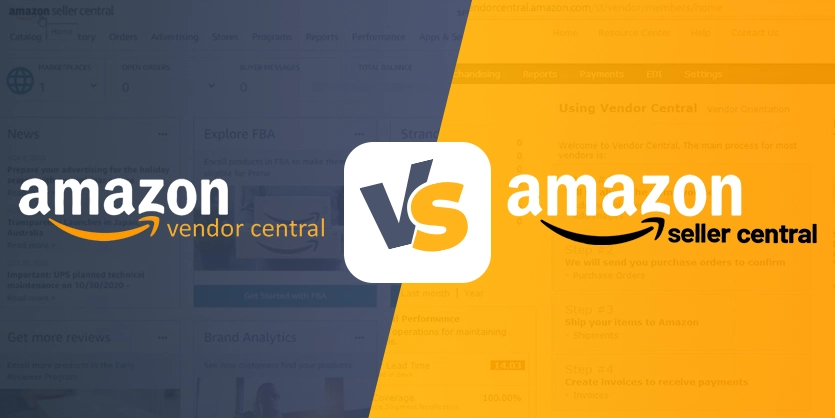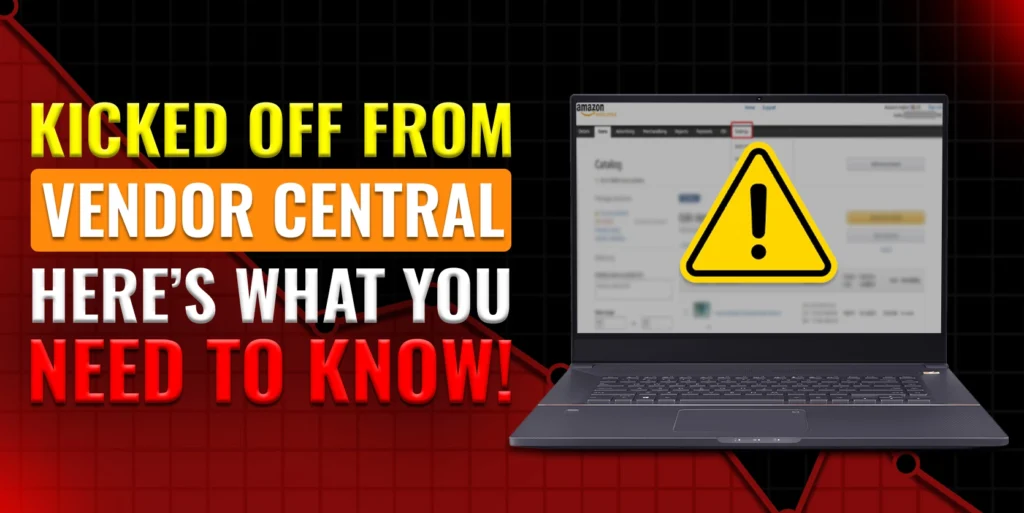Are you ready to take your business to the next level by selling on Amazon? It’s important to choose the right platform that best fits your business needs. Amazon offers two main platforms: Vendor Central and Seller Central. Depending on the type of your business each platform has its advantages and challenges. To make the best choice for your business, it’s ideal to understand the differences between Vendor Central and Seller Central.
In this article, we will cover:
- The difference between Amazon Vendor Center and Amazon Seller Central
- Pros and Cons of Amazon Vendor Central
- Pros and Cons of Amazon Seller Central
- Amazon Vendor Central vs. Amazon Seller Central: Which is more profitable
- Amazon Vendor Central vs. Amazon Seller Central: Which one you should choose
Differences between Amazon Vendor Central and Amazon Seller Central
Amazon Vendor Central and Amazon Seller Central are two distinct platforms that sellers and vendors use to manage their sales on Amazon. Here are the key differences between the two:
Amazon Vendor Central
Amazon Vendor Central is a platform where manufacturers, wholesalers, and distributors can sell their products directly to Amazon. It allows vendors to manage their wholesale business relationship with Amazon, including product listings, inventory management, and order fulfillment. This platform is designed for large businesses with an extensive product catalog, and sellers receive invitations from Amazon.
Sellers may perform the following activities in Amazon Vendor Central:
- Create and manage listing
- Set the price and inventory level
- Receive purchase orders from Amazon
- Communicate with Amazon
- Track sales and orders
- Use Amazon reporting
- Allows you to use the Amazon Vine program
Amazon Seller Central
Amazon Seller Central allows individuals and businesses to sell their products directly to customers on Amazon’s online marketplace. Sellers can manage their inventory, process orders, set pricing, and handle customer service through Seller Central. It provides tools and resources for sellers to track sales, analyze performance, and optimize their listings to maximize their success on the platform.
Sellers may perform the following activities in Amazon Seller Central:
- Create and manage listing
- Set the price and inventory level
- Track sales and orders
- Communicate with customers
- Allows you to use Amazon tools and analytics
The Key Differences Between Amazon Vendor Central and Amazon Seller Central Here are some key points about the differences between these two programs.
Control: Amazon Seller Central offers more control over pricing, inventory, and marketing. On the other hand, Amazon Vendor Central provides a more hands-off approach where Amazon manages much of the process.
Eligibility: Vendor Central is invitation-only, suitable for larger brands and manufacturers. Seller Central is open to anyone, making it accessible to small businesses and individual sellers.
Pricing: Vendors typically sell at wholesale prices, which might be lower than retail prices set by sellers on Seller Central.
Fulfillment and logistics: Vendor Central handles all logistics, while Seller Central sellers have the flexibility to choose their fulfillment method.
Both of these platforms have their unique advantages. Both of these business platforms require different business needs and strategies.
Pros and Cons of Amazon Vendor Central
Selling products directly to Amazon has good sides and bad sides. The pros and cons of Amazon Vendor Central are discussed below:
Pros of Amazon Vendor Central
Access to a large audience: Amazon has a massive global customer base all over the world. So vendors can get exposure to millions of potential buyers.
Brand exposure: Selling directly on Amazon boosts your brand’s visibility and credibility. Your products appear alongside famous brands, giving you a similar spotlight. This exposure helps more customers discover and trust your products.
Prime eligibility: Vendor Central offers prime eligibility often to the vendors for Amazon Prime, which can attract more customers due to its fast and free shipping benefits.
Security of wholesale: When you sell to Amazon in bulk, you’re assured of making money on a larger scale. Plus, as your partnership grows, you might get better deals and terms for your sales.
Marketing opportunities: Amazon provides a range of marketing tools and programs to help vendors boost their product visibility and drive more sales.
Cons of Amazon Vendor Central
Loss of control: As a vendor, you may have less control over pricing, product presentation, and branding compared to selling through your channels. Amazon sets retail prices and may make changes to product listings without consulting vendors.
Fees and margins: Amazon charges different fees, like referral fees and fulfillment fees, which can take up to 25% of what you make from sales. Vendors have to watch their prices and expenses closely to make sure they’re still making money.
Payment terms: Amazon might take up to 90 days to pay you, which could cause cash flow problems for your business.
Limited customer data: Although Amazon offers some sales data and analytics, vendors may not see as much customer information as they would with their own sales channels. This can make it harder to create focused marketing plans and connect with customers.
Dependency on Amazon: Relying too much on Amazon for sales can be risky because changes in Amazon’s rules or how the marketplace works can affect your business. To lower this risk, it’s smart to sell your products in other places too.
Pros and Cons of Amazon Seller Central
Amazon Seller Central is a platform that allows third-party sellers to list and sell products directly on Amazon. Here are the key pros and cons of using Amazon Seller Central:
Pros of Amazon Seller Central
Fulfillment by Amazon (FBA): Sellers can use FBA to have Amazon handle storage, shipping, customer service, and returns. This can lead to faster shipping times and higher customer satisfaction.
Brand visibility and trust: Products listed on Amazon benefit from the trust and credibility associated with the Amazon brand. This can increase conversion rates.
Advertising and promotional tools: Sellers have access to various advertising options, such as Sponsored Products and Sponsored Brands, to boost visibility and sales.
International expansion: Amazon’s global marketplaces enable sellers to expand their business to other countries relatively easily.
Control over product price: Amazon Seller Central gives sellers complete control over the pricing of their products. Because you are selling products on Amazon, you can easily adjust the price of your products based on your competitors.
Cons of Amazon Seller Central
Fees and Costs: Selling on Amazon involves various fees, including referral fees, FBA fees, and storage fees. These can significantly impact profit margins.
Competitive Marketplace: The marketplace is highly competitive, with many sellers offering similar products. Price wars and competitive pricing strategies can erode profits.
Strict Policies and Guidelines: Amazon has stringent rules and guidelines. Sellers risk account suspensions or bans for policy violations, which can be disruptive.
Limited Customer Relationship: Amazon owns the customer relationship, and sellers have limited opportunities to build a direct relationship with buyers. Access to customer data is also restricted.
Inventory Management Challenges: Managing inventory efficiently, especially when using FBA, requires careful planning to avoid stockouts or excessive storage fees.
Which is More Profitable?
Amazon Vendor Central has the advantage of making a profit easily. But sellers need to negotiate pricing and terms with Amazon properly. If sellers can set a profitable wholesale price, they can earn a profit from the wholesale. However, after negotiating, you need to sign a vendor agreement. Once you sell your bulk items to Amazon, it’s Amazon’s responsibility to deal with the customers.
However, Amazon Seller Central is nothing like that. To earn profit, sellers have to handle more of the logistics themselves, such as pricing strategy, inventory management, shipping processes, fulfillment methods, customer relationships, etc.
Which One You Should Choose?
Choosing between Amazon Vendor Central and Amazon Seller Central depends on your business’s needs and goals. If you are a third-party seller, then Seller Central is best for you. But if you are the first party, then Vendor Central is for you.
If you want more control, higher margins, and are prepared to manage sales operations, then choose Amazon Seller Central. Choose Vendor Central if you prefer a hands-off approach, can handle lower margins, and meet Amazon’s eligibility criteria.
In conclusion, the choice between Amazon Vendor Central and Amazon Seller Central depends largely on your business model. We tried to draw a perfect overview between these two business models to help with business selection. Both of these business platforms have advantages with some drawbacks. It is important to carefully consider your business needs, resources, and long-term goals to determine which platform will best support your success on Amazon.
If you need any help with Amazon, feel free to let us know in the comment box or email us at the following email address: info@ecomclips.com
To know more about Amazon or other marketplace, please check out our other blog. Also, you can check our YouTube videos related to Amazon as well.



